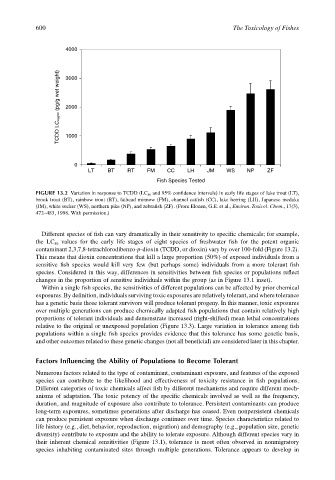Page 620 - The Toxicology of Fishes
P. 620
600 The Toxicology of Fishes
4000
TCDD LCegg50 (pg/g wet weight) 3000
2000
1000
0
LT BT RT FM CC LH JM WS NP ZF
Fish Species Tested
FIGURE 13.2 Variation in response to TCDD (LC 50 and 95% confidence intervals) in early life stages of lake trout (LT),
brook trout (BT), rainbow trout (RT), fathead minnow (FM), channel catfish (CC), lake herring (LH), Japanese medaka
(JM), white sucker (WS), northern pike (NP), and zebrafish (ZF). (From Elonen, G.E. et al., Environ. Toxicol. Chem., 17(3),
472–483, 1998. With permission.)
Different species of fish can vary dramatically in their sensitivity to specific chemicals; for example,
the LC values for the early life stages of eight species of freshwater fish for the potent organic
50
contaminant 2,3,7,8-tetrachlorodibenzo-p-dioxin (TCDD, or dioxin) vary by over 100-fold (Figure 13.2).
This means that dioxin concentrations that kill a large proportion (50%) of exposed individuals from a
sensitive fish species would kill very few (but perhaps some) individuals from a more tolerant fish
species. Considered in this way, differences in sensitivities between fish species or populations reflect
changes in the proportion of sensitive individuals within the group (as in Figure 13.1 inset).
Within a single fish species, the sensitivities of different populations can be affected by prior chemical
exposures. By definition, individuals surviving toxic exposures are relatively tolerant, and where tolerance
has a genetic basis those tolerant survivors will produce tolerant progeny. In this manner, toxic exposures
over multiple generations can produce chemically adapted fish populations that contain relatively high
proportions of tolerant individuals and demonstrate increased (right-shifted) mean lethal concentrations
relative to the original or unexposed population (Figure 13.3). Large variation in tolerance among fish
populations within a single fish species provides evidence that this tolerance has some genetic basis,
and other outcomes related to these genetic changes (not all beneficial) are considered later in this chapter.
Factors Influencing the Ability of Populations to Become Tolerant
Numerous factors related to the type of contaminant, contaminant exposure, and features of the exposed
species can contribute to the likelihood and effectiveness of toxicity resistance in fish populations.
Different categories of toxic chemicals affect fish by different mechanisms and require different mech-
anisms of adaptation. The toxic potency of the specific chemicals involved as well as the frequency,
duration, and magnitude of exposure also contribute to tolerance. Persistent contaminants can produce
long-term exposures, sometimes generations after discharge has ceased. Even nonpersistent chemicals
can produce persistent exposure when discharge continues over time. Species characteristics related to
life history (e.g., diet, behavior, reproduction, migration) and demography (e.g., population size, genetic
diversity) contribute to exposure and the ability to tolerate exposure. Although different species vary in
their inherent chemical sensitivities (Figure 13.1), tolerance is most often observed in nonmigratory
species inhabiting contaminated sites through multiple generations. Tolerance appears to develop in

